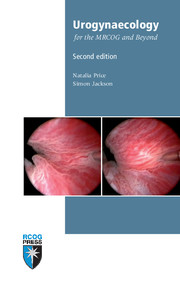Book contents
- Frontmatter
- Contents
- Preface
- Abbreviations
- 1 Applied anatomy and physiology of the lower urinary tract
- 2 Definition and prevalence of urinary incontinence
- 3 Initial assessment of lower urinary tract symptoms
- 4 Further investigation of lower urinary tract symptoms
- 5 Management of stress urinary incontinence
- 6 Management of overactive bladder syndrome
- 7 Recurrent urinary tract infection
- 8 Haematuria
- 9 Painful bladder syndrome and interstitial cystitis
- 10 Pregnancy and the renal tract
- 11 Ageing and urogenital symptoms
- 12 Fistulae and urinary tract injuries
- 13 Pelvic organ prolapse
- 14 Colorectal disorders
- 15 Obstetric anal sphincter injuries
- Index
Preface
Published online by Cambridge University Press: 05 July 2014
- Frontmatter
- Contents
- Preface
- Abbreviations
- 1 Applied anatomy and physiology of the lower urinary tract
- 2 Definition and prevalence of urinary incontinence
- 3 Initial assessment of lower urinary tract symptoms
- 4 Further investigation of lower urinary tract symptoms
- 5 Management of stress urinary incontinence
- 6 Management of overactive bladder syndrome
- 7 Recurrent urinary tract infection
- 8 Haematuria
- 9 Painful bladder syndrome and interstitial cystitis
- 10 Pregnancy and the renal tract
- 11 Ageing and urogenital symptoms
- 12 Fistulae and urinary tract injuries
- 13 Pelvic organ prolapse
- 14 Colorectal disorders
- 15 Obstetric anal sphincter injuries
- Index
Summary
While the upper renal tract remains the sole preserve of the urologist, gynaecologists in addition to urologists have traditionally been involved in the assessment and treatment of female lower urinary tract symptoms. There are sound reasons for this: childbirth is a major aetiological factor, and women often present with a combination of menstrual, genital, urinary and colorectal symptoms that requires a holistic approach. It is for this reason that the subspecialty of urogynaecology has arisen. Clinicians who treat women with these symptoms require a thorough understanding of the assessment and treatment of bladder filling and storage disorders, pelvic organ prolapse and colorectal disorders, and need to work closely with allied professions. This text aims to introduce those aspects of pelvic floor disorders that clinicians are likely to encounter in their capacity as general obstetricians and gynaecologists. References are provided to guide the interested clinician who wishes to review a particular subject comprehensively.
- Type
- Chapter
- Information
- Publisher: Cambridge University PressPrint publication year: 2012

